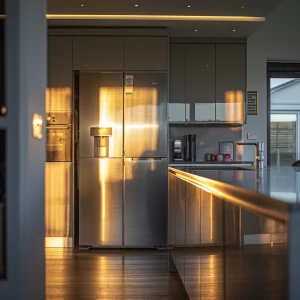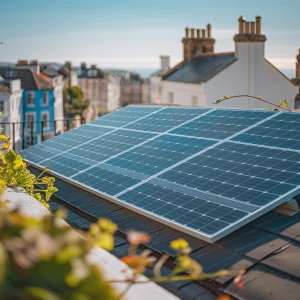
In the contemporary landscape of UK living, particularly in flats, managing energy expenses effectively while maintaining a comfortable home environment is paramount. With rising energy prices, it becomes crucial for residents in these settings to implement strategies that are both economically viable and environmentally sustainable.
This discussion delves into several nuanced methods individuals in UK flats can adopt to optimise their energy consumption without compromising comfort. These methods encompass a broad spectrum, from thermal regulation to more sophisticated approaches like renewable energy investments, tailored to the unique challenges and opportunities presented by flat living.
Thermal Regulation
One of the fundamental strategies for reducing energy bills is enhancing thermal regulation within the flat. This involves a suite of adjustments that improve heat retention and manage the indoor climate more efficiently. Double-glazed windows are a premier solution; these windows reduce heat loss and insulate the home against external noise, providing a quieter and warmer indoor environment. Applying draught-proofing measures—such as sealing gaps around doors and windows—further prevents cold air intrusion and heat escape.
Additionally, adjusting interior furnishings can also play a significant role. For instance, the strategic placement of thick, insulated curtains can drastically reduce the heat lost through windows, particularly in the colder months. Similarly, rugs and carpets on floors can act as an extra insulation layer, especially in flats with hard flooring. Ensuring that radiators are unobstructed by furniture and employing reflective foil behind them can also enhance the efficiency of heat distribution throughout the living spaces.
Appliance Optimisation

Shifting focus to household appliances selecting those with ENERGY STAR ratings can lead to substantial energy savings. These appliances are designed to be more energy-efficient than their standard counterparts, reducing overall electricity usage and energy bills. Integrating smart meters is another strategic approach; these devices provide real-time data on energy consumption, empowering residents to make informed decisions about their energy use.
Investing in appliances that consume less energy for routine tasks can also yield long-term savings. For example, using a microwave or a slow cooker instead of a conventional oven can significantly reduce energy consumption, as these devices tend to use less electricity and require shorter operating times to prepare meals.
Behavioural Adjustments
Behavioural changes are often underestimated yet powerful tools for energy conservation. Simple actions like lowering the thermostat by just a few degrees can result in noticeable reductions in heating costs without a drastic impact on comfort. Dressing warmly in layers during colder months allows for lower thermostat settings, thus conserving heat without sacrificing comfort.
Moreover, adopting a conscious approach to daily habits can further help cut energy costs. Turning off lights when unoccupied rooms, unplugging electronic devices when not in use, and reducing shower times are all effective measures. These habits contribute to lower energy consumption, which translates to reduced energy bills.
Lighting Efficiency
Regarding lighting, the transition to LED bulbs is a relatively inexpensive yet highly effective energy-saving measure. LEDs are more durable and consume a fraction of the energy used by traditional incandescent bulbs. Maximising natural light during the day can also decrease the need for artificial lighting, saving energy and enhancing overall well-being by boosting mood and productivity.
Sensor-activated lighting is another innovative solution that ensures lights are only on when needed. This eliminates the common issue of lights being left running in unoccupied rooms or during daylight hours. This technology is particularly beneficial in communal areas of flats where controlling light usage can otherwise be challenging.
Water Conservation

Effective water usage management is another critical component of reducing energy bills. Installing low-flow fixtures such as showerheads and taps can dramatically decrease water consumption while maintaining adequate water pressure. Lowering the water heating temperature is a straightforward adjustment that can yield significant energy savings. Water heaters often work on high settings by default, but reducing the temperature setting can lower energy use without impacting the comfort of the hot water available.
Insulating hot water pipes is an often-overlooked strategy to prevent heat loss as water travels from the heater to the taps. This ensures that less energy is required to heat the water to the desired temperature and maintains the water’s heat for extended periods, thereby reducing the need for re-heating. Encouraging residents to prefer showers over baths can also significantly reduce water and energy use, as baths typically require more hot water than showers.
Energy Monitoring and Management
Smart meters and advanced thermostat systems play a pivotal role in energy management. These devices allow for precise real-time monitoring and control of energy usage. By understanding usage patterns, residents can identify areas where energy is wasted and adjust accordingly. Regular energy audits are invaluable in this process, helping to pinpoint specific issues such as insulation flaws or outdated appliances that consume excessive power.
Further, these audits can guide the decision-making process when considering upgrades or replacements, ensuring that investments are made strategically to optimise energy savings. This proactive approach helps manage costs and contributes to the broader goal of environmental conservation.
Utility Comparison and Negotiation
An often underutilised strategy is the regular comparison of energy suppliers. Market dynamics can shift, presenting new opportunities for cost savings through different tariffs or special offers. Negotiating with current suppliers or switching to a more cost-effective provider can significantly reduce utility bills. While requiring some initial research and engagement, this practice can lead to substantial long-term savings.
Moreover, considering greener energy suppliers is beneficial for the environment and can also be economically advantageous. Many green suppliers offer competitive rates, and using renewable energy sources can provide more price stability over time.
Community and Financial Planning
Engaging with community initiatives can offer additional resources and support in managing energy costs. Many communities have programs that provide shared resources, such as bulk-buying discounts for energy-saving products or communal renewable energy projects like solar panel installations.
Financial planning is also crucial. By setting aside a budget for energy efficiency improvements, residents can invest in upgrades that reduce costs in the long run. This might include energy-efficient appliances, better insulation, or even renewable energy sources.
Renewable Energy and Infrastructure Management

For those in a position to invest more significantly, renewable energy sources such as solar panels represent an excellent opportunity to cut energy bills while reducing carbon footprints. While the initial setup costs can be high, the long-term savings and environmental benefits are substantial.
Prompt reporting and management of maintenance issues in flats also prevent unnecessary energy wastage. A dripping tap or a malfunctioning boiler can lead to higher water and energy consumption. Efficient infrastructure management ensures that such issues are resolved quickly, preventing minor problems from becoming more significant and expensive.
Sustainable Habits and Regulatory Awareness
Developing sustainable habits is crucial for long-term energy conservation. Mindful consumption, particularly during peak hours, can substantially reduce energy costs. Peak hours often coincide with higher energy rates; thus, shifting high-energy-consuming activities to off-peak times can result in lower electricity bills. Such behaviours promote sustainability and encourage a more balanced energy load on the grid, which can prevent outages and reduce the need for expensive energy production during peak times.
Awareness of tenant rights and energy efficiency grants is another vital component. Many residents might not be fully aware of the legal protections and incentives available which can support their efforts in making energy-efficient home improvements. For instance, specific grants are designed to cover or subsidise the cost of insulation, solar panel installations, and high-efficiency boilers. Staying informed about these options can provide the necessary financial support to implement significant changes, promoting energy efficiency.
Final Thoughts
In conclusion, effectively managing energy in UK flats is a multifaceted endeavour that extends beyond individual action to include community involvement and strategic financial planning. By adopting a range of energy-saving practices, from simple behavioural adjustments to significant investments in renewable technologies, residents can significantly reduce their energy costs while enhancing their comfort and contributing to environmental sustainability.
This holistic approach fosters a more energy-efficient living environment. It encourages a broader cultural shift towards more sustainable practices, demonstrating the profound impact that informed, collective action can have on our society’s energy future.